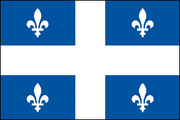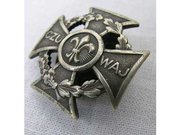Fleur-de-lis
|
|

Tape_de_bouche_Jeanne.jpg
The fleur-de-lis (also spelled fleur-de-lys; plural fleurs-de-lis or -lys; an archaic spelling is fleur-de-luce) is used in heraldry, where it is particularly associated with the French monarchy (see King of France).
Origins
The name, anglicized, means "lily flower", and the symbol is in fact a stylized Iris pseudacorus L.. It was adopted by King Philip I of France in the 11th century. His grandson Louis VII was the first to adopt the Azure semé-de-lis Or (a blue shield with a tight pattern of small golden fleur-de-lis) as his badge, and this came to be so closely associated with his country that it is now known as "France Ancient". Three gold flowers on a blue background ("France Modern") dates to 1376 and Charles V of France.
The fleur-de-lis' origins with French monarchs stems from the baptismal lily used in the crowning of King Clovis I. To further enhance its mystique, a legend eventually sprang up that a vial of oil descended from heaven to anoint and sanctify Clovis as King. The thus "anointed" Kings of France later maintained that their authority was directly from God, without the mediation of either the Emperor or the Pope. Other legends claim that even the lily itself appeared at the baptismal ceremony as a gift of blessing in an apparition of the Blessed Virgin Mary. The Catholic Church later endorsed the legend by associating Mary with the symbol. There are many other legends, that state for instance that Clovis saw an angel, among others.
Contrary to popular belief, the fleur-de-lis did not originate in France. Although this is debated by some scholars, it was allegedly inherited from the Ancient Egyptian symbol for circumcision, later adopted by the ruling class of the Roman Empire, probably due to religious influences. After the fall of Empire it was inherited to symbolize the sacred origin of the Merovingian dynasty and then became a symbol of the entire Christian French Kingdom. Modern, unconfirmed, theories about the Holy Grail see in the fleur-de-lis a symbol of the mythical holy origin of the French nation in the union of legendary King Meroveus with Mary Magdalene's descendancy given to her by Jesus.
By the 13th and 14th centuries, the three petals of the lily of France were being described by writers as symbols of faith, wisdom and chivalry. As in Ireland, they also came to be seen as symbols of the Holy Trinity. By the 14th century, the fleur-de-lis had become so closely associated with the rule of France that the English king Edward III quartered his coat of arms with France Ancient in order to emphasize his claim on the French crown. This quartering was changed to France Modern in the early 1400s. The fleur-de-lis was not removed until 1801, when George III gave up his formal claim to the French throne.
- The treasured fleur-de-luce he claims
- To wreathe his shield, since royal James
- Sir Walter Scott, The Lay of the Last Minstrel, Canto Fourth, VIII
- from The Complete Works of Sir Walter Scott, Volume 1 of 7, Conner and Cooke, New York, 1833
Fleurs-de-lis feature prominently in the Crown Jewels of both Scotland and England and have been heraldic devices of those monarchs since very early on. The tressure flory-counterflory is a prominent part of the design of the Scottish royal arms and flag since James I of Scotland. In English heraldry, the fleur-de-lis is the cadency mark of difference of the sixth son.
Modern usage
France Modern remained the French royal standard, and with a white background was the French national flag until the French Revolution, when it was replaced by the tri-colour flag of modern-day France. The fleur-de-lis was restored to the French flag in 1814, but replaced once again after the revolution against Charles X of France in 1830. The "France modern" fleur-de-lys pattern is also on the coat of arms of the Île-de-France region (as for instance as a badge on the uniforms of the local gendarmerie legion).
In 1948, a new flag of Quebec was introduced that incorporated the fleur-de-lis. Prior to this, the Union Jack had flown over Quebec's legislature.
Other notable places or institutions that use the symbol informally or as part of their heraldic arms are: Quebec; Canada; Spain (ruled by the Bourbons); Augsburg, Germany; Florence, Italy (whose lis-sporting currency fiorino influenced the Dutch gulden and Hungarian forint); Laško, Slovenia; the Fuggers medieval banking family; the House of Lancaster; Bosniaks in Bosnia and Herzegovina (who call it Lillicum Bosniacum); the Boy Scouts; New Orleans, Louisiana, Detroit, Michigan, Louisville, Kentucky, and Saint Louis, Missouri.
The symbol is also often used on a compass rose to mark the north direction.
The U.S. Navy Blue Angels flight demonstration team perform a manœuvre they call the "fleur-de-lis". In this manœuvre five aircraft (in a formation they call the "stinger diamond") pull gracefully to a straight vertical direction while trailing white smoke. The four lead aircraft break formation and perform partial loops in four different compass directions. The trailing aircraft continues vertically while performing a continuous roll.
The fleur-de-lis is a popular symbol of New Orleans, used in a lot of New Orleans art and architecture. A black fleur-de-lis is also the logo of the New Orleans Saints football team.
Brazilian author Aluísio Azevedo wrote a play entitled Fleur-de-lis.
External links
- Heraldica.org (http://www.heraldica.org/topics/fdl.htm)de:Fleur-de-Lis
fr:Fleur de lys it:Giglio araldico he:פרח החבצלת nl:Fleur-de-Lys


